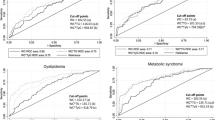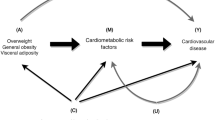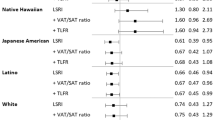Abstract
After metabolic syndrome was first introduced to identify persons at greater cardiovascular disease (CVD) risk, it has been associated with an increased risk of CVD and type 2 diabetes (T2D). Obesity has been considered as the fundamental factor in metabolic syndrome and it is thought to be mediated, at least in part by the role of the adipocyte in controlling circulating free fatty acids and the development of insulin resistance. However, the obese population is not perfectly overlapped with the population with metabolic syndrome. Is metabolic syndrome a better predictor than obesity to prevent CVD and T2D? Has metabolic syndrome been considered as a cluster of risk factors or an additional independent risk factor to assess CVD and T2D risk? The debate on the necessity of metabolic syndrome diagnosis seems not to be ended. Various definitions of metabolic syndrome were advocated by different organizations with emphasis on different components, and these definitions have different abilities to predict CVD and T2D among different populations because of fundamental philosophical differences. In the definitions of metabolic syndrome, only the cutoffs of each component were presented but rather continuous values or the degree of the severity of the syndrome with multiple cutoffs. Moreover, metabolic syndrome did not incorporate all the risk factors as known for CVD and T2D, such as physical activity. Future prospective studies with the measurement of sophisticated metabolic markers and of abdominal visceral and subcutaneous adiposity are needed to examine if the metabolic syndrome is a good CVD and T2D risk predictor over obesity and other risk factors. In practice, prevention action should be taken at the stage of obesity and providers need to pay attention to any components in the definition of metabolic syndrome even if the number of positive components has not achieved three or more.
This is a preview of subscription content, access via your institution
Access options
Subscribe to this journal
Receive 12 print issues and online access
$259.00 per year
only $21.58 per issue
Buy this article
- Purchase on Springer Link
- Instant access to full article PDF
Prices may be subject to local taxes which are calculated during checkout
Similar content being viewed by others
References
WHO. Global atlas on cardiovascular disease prevention and control: policies, strategies and interventions 2011.
WHO. Diabetes: Fact sheet no. 312 2011.
Daniels SR, Arnett DK, Eckel RH, Gidding SS, Hayman LL, Kumanyika S et al. Overweight in children and adolescents: pathophysiology, consequences, prevention, and treatment. Circulation 2005; 111: 1999–2012.
Alberti KG, Zimmet PZ . Definition, diagnosis and classification of diabetes mellitus and its complications. Part 1: Diagnosis and classification of diabetes mellitus provisional report of a who consultation. Diabet Med 1998; 15: 539–553.
Grundy SM, Brewer HB, Cleeman JI, Smith SC, Lenfant C . Definition of metabolic syndrome: report of the national heart, lung, and blood institute/american heart association conference on scientific issues related to definition. Circulation 2004; 109: 433–438.
The idf consensus worldwide definition of the metabolic syndrome. Part I. Worldwide definition fur use in clinical practice. 2005. Available at: http://www.Idf.Org/webdata/docs/metac_syndrome_def.Pdf accessed on 7 August 2012.
Reaven GM . Banting lecture 1988. Role of insulin resistance in human disease. Diabetes 1988; 37: 1595–1607.
Ahmed A, Khan TE, Yasmeen T, Awan S, Islam N . Metabolic syndrome in type 2 diabetes: comparison of who, modified atpiii & idf criteria. J Pak Med Assoc 2012; 62: 569–574.
Chang JJ, Chu CM, Wang PC, Lin YS, Pan KL, Jang SJ et al. Differences in prevalence and severity of coronary artery disease by three metabolic syndrome definitions. Can J Cardiol 2012; 28: 208–214.
Vinluan CM, Zreikat HH, Levy JR, Cheang KI . Comparison of different metabolic syndrome definitions and risks of incident cardiovascular events in the elderly. Metabolism 2012; 61: 302–309.
Nilsson PM, Engstrom G, Hedblad B . The metabolic syndrome and incidence of cardiovascular disease in non-diabetic subjects–a population-based study comparing three different definitions. Diabet Med 2007; 24: 464–472.
Despres JP, Lemieux I, Bergeron J, Pibarot P, Mathieu P, Larose E et al. Abdominal obesity and the metabolic syndrome: contribution to global cardiometabolic risk. Arterioscler Thromb Vasc Biol 2008; 28: 1039–1049.
Liese AD, Mayer-Davis EJ, Haffner SM . Development of the multiple metabolic syndrome: an epidemiologic perspective. Epidemiol Rev 1998; 20: 157–172.
Reaven GM . The metabolic syndrome: is this diagnosis necessary? Am J Clin Nutr 2006; 83: 1237–1247.
Lebovitz HE . The relationship of obesity to the metabolic syndrome. Int J Clin Prac 2003; 134 (Suppl), 18–27.
Weiss R, Dziura J, Burgert TS, Tamborlane WV, Taksali SE, Yeckel CW et al. Obesity and the metabolic syndrome in children and adolescents. New Engl J Med 2004; 350: 2362–2374.
Cruz ML, Weigensberg MJ, Huang TT, Ball G, Shaibi GQ, Goran MI . The metabolic syndrome in overweight hispanic youth and the role of insulin sensitivity. J Clin Endocrinol Metab 2004; 89: 108–113.
DeFronzo RA, Ferrannini E . Insulin resistance. A multifaceted syndrome responsible for niddm, obesity, hypertension, dyslipidemia, and atherosclerotic cardiovascular disease. Diabetes Care 1991; 14: 173–194.
Miranda PJ, DeFronzo RA, Califf RM, Guyton JR . Metabolic syndrome: definition, pathophysiology, and mechanisms. Am Heart J 2005; 149: 33–45.
Bergman RN, Kim SP, Catalano KJ, Hsu IR, Chiu JD, Kabir M et al. Why visceral fat is bad: mechanisms of the metabolic syndrome. Obesity 2006; 14 (Suppl 1), 16S–19S.
Ogden CL, Carroll MD . Prevalence of obesity among children and adolescents: United States, trends 1963–1965 through 2007-2008. NCHS Health E-Stat 2010, Available from http://www.cdc.gov/nchs/data/hestat/obesity_child_07_08/obesity_child_07_08.pdf.
Ford ES, Giles WH, Dietz WH . Prevalence of the metabolic syndrome among us adults: findings from the third national health and nutrition examination survey. JAMA 2002; 287: 356–359.
Ervin RB . Prevalence of metabolic syndrome among adults 20 years of age and over, by sex, age, race and ethnicity, and body mass index: United states, 2003–2006. Natl Health Statis Rep 2009; 13: 1–7.
Park YW, Zhu S, Palaniappan L, Heshka S, Carnethon MR, Heymsfield SB . The metabolic syndrome: prevalence and associated risk factor findings in the us population from the third national health and nutrition examination survey, 1988–1994. Arch Int Med 2003; 163: 427–436.
Abbasi F, Brown BW, Lamendola C, McLaughlin T, Reaven GM . Relationship between obesity, insulin resistance, and coronary heart disease risk. J Am College Cardiol 2002; 40: 937–943.
McLaughlin T, Abbasi F, Cheal K, Chu J, Lamendola C, Reaven G . Use of metabolic markers to identify overweight individuals who are insulin resistant. Ann Int Med 2003; 139: 802–809.
Farin HM, Abbasi F, Reaven GM . Body mass index and waist circumference correlate to the same degree with insulin-mediated glucose uptake. Metabolism 2005; 54: 1323–1328.
Despres JP, Lemieux I . Abdominal obesity and metabolic syndrome. Nature 2006; 444: 881–887.
Oppert JM, Charles MA, Thibult N, Guy-Grand B, Eschwege E, Ducimetiere P . Anthropometric estimates of muscle and fat mass in relation to cardiac and cancer mortality in men: the paris prospective study. Am J Clin Nutr 2002; 75: 1107–1113.
Wang Z, Heymsfield SB, Chen Z, Zhu S, Pierson RN . Estimation of percentage body fat by dual-energy X-ray absorptiometry: evaluation by in vivo human elemental composition. Phys Med Biol 2010; 55: 2619–2635.
Roubenoff R, Kehayias JJ, Dawson-Hughes B, Heymsfield SB . Use of dual-energy X-ray absorptiometry in body-composition studies: not yet a ‘gold standard’. Am J Clin Nutr 1993; 58: 589–591.
Despres JP . Is visceral obesity the cause of the metabolic syndrome? Ann Med 2006; 38: 52–63.
Ross R, Aru J, Freeman J, Hudson R, Janssen I . Abdominal adiposity and insulin resistance in obese men. Am J Physiol Endocrinol Metab 2002; 282: E657–E663.
Ross R, Freeman J, Hudson R, Janssen I . Abdominal obesity, muscle composition, and insulin resistance in premenopausal women. J Clin Endocrinol Metab 2002; 87: 5044–5051.
Wilson PW, D’Agostino RB, Parise H, Sullivan L, Meigs JB . Metabolic syndrome as a precursor of cardiovascular disease and type 2 diabetes mellitus. Circulation 2005; 112: 3066–3072.
Despres JP, Couillard C, Gagnon J, Bergeron J, Leon AS, Rao DC et al. Visceral adipose tissue, plasma lipids, and lipoprotein lipase activity in men and women: the health, risk factors, exercise training, and genetics (heritage) family study. Arterioscler Thromb Vasc Biol 2000; 20: 1932–1938.
Lovejoy JC, de la Bretonne JA, Klemperer M, Tulley R . Abdominal fat distribution and metabolic risk factors: effects of race. Metabolism 1996; 45: 1119–1124.
Kadowaki T, Sekikawa A, Murata K, Maegawa H, Takamiya T, Okamura T et al. Japanese men have larger areas of visceral adipose tissue than caucasian men in the same levels of waist circumference in a population-based study. Int J Obes 2006; 30: 1163–1165.
Wei M, Kampert JB, Barlow CE, Nichaman MZ, Gibbons LW, Paffenbarger RS et al. Relationship between low cardiorespiratory fitness and mortality in normal-weight, overweight, and obese men. JAMA 1999; 282: 1547–1553.
Farrell SW, Cheng YJ, Blair SN . Prevalence of the metabolic syndrome across cardiorespiratory fitness levels in women. Obes Res 2004; 12: 824–830.
Williams PT . Physical fitness and activity as separate heart disease risk factors: a meta-analysis. Med Sci Sports Exer 2001; 33: 754–761.
Boule NG, Haddad E, Kenny GP, Wells GA, Sigal RJ . Effects of exercise on glycemic control and body mass in type 2 diabetes mellitus: a meta-analysis of controlled clinical trials. JAMA 2001; 286: 1218–1227.
Katzmarzyk PT, Church TS, Janssen I, Ross R, Blair SN . Metabolic syndrome, obesity, and mortality: impact of cardiorespiratory fitness. Diabetes Care 2005; 28: 391–397.
Conroy RM, Pyorala K, Fitzgerald AP, Sans S, Menotti A, De Backer G et al. Estimation of ten-year risk of fatal cardiovascular disease in europe: the score project. Eur Heart J 2003; 24: 987–1003.
Kahn R, Buse J, Ferrannini E, Stern M . The metabolic syndrome: time for a critical appraisal: Joint statement from the american diabetes association and the european association for the study of diabetes. Diabetes Care 2005; 28: 2289–2304.
Hartemink N, Boshuizen HC, Nagelkerke NJ, Jacobs MA, van Houwelingen HC . Combining risk estimates from observational studies with different exposure cutpoints: a meta-analysis on body mass index and diabetes type 2. Am J Epidemiol 2006; 163: 1042–1052.
Lee IM, Manson JE, Hennekens CH, Paffenbarger RS . Body weight and mortality A 27-year follow-up of middle-aged men. JAMA 1993; 270: 2823–2828.
Manson JE, Willett WC, Stampfer MJ, Colditz GA, Hunter DJ, Hankinson SE et al. Body weight and mortality among women. New Engl J Med 1995; 333: 677–685.
Vandenbroucke JP, Mauritz BJ, de Bruin A, Verheesen JH, van der Heide-Wessel C, van der Heide RM . Weight, smoking, and mortality. JAMA 1984; 252: 2859–2860.
Harris T, Cook EF, Garrison R, Higgins M, Kannel W, Goldman L . Body mass index and mortality among nonsmoking older persons. The framingham heart study. JAMA 1988; 259: 1520–1524.
Ford ES, Li C, Sattar N . Metabolic syndrome and incident diabetes: current state of the evidence. Diabetes Care 2008; 31: 1898–1904.
Mottillo S, Filion KB, Genest J, Joseph L, Pilote L, Poirier P et al. The metabolic syndrome and cardiovascular risk a systematic review and meta-analysis. J Am College Cardiol 2010; 56: 1113–1132.
Author information
Authors and Affiliations
Corresponding author
Ethics declarations
Competing interests
The authors declare no conflict of interest.
Rights and permissions
About this article
Cite this article
Ma, X., Zhu, S. Metabolic syndrome in the prevention of cardiovascular diseases and diabetes—still a matter of debate?. Eur J Clin Nutr 67, 518–521 (2013). https://doi.org/10.1038/ejcn.2013.24
Received:
Accepted:
Published:
Issue Date:
DOI: https://doi.org/10.1038/ejcn.2013.24
Keywords
This article is cited by
-
Metabolic syndrome showed significant relationship with carotid atherosclerosis
Heart and Vessels (2016)
-
‘Red Ruby’: an interactive web-based intervention for lifestyle modification on metabolic syndrome: a study protocol for a randomized controlled trial
BMC Public Health (2014)
-
Maternal and In Utero Determinants of Type 2 Diabetes Risk in the Young
Current Diabetes Reports (2014)



